The power output of a microwave oven is a constant value determined by the design of the oven itself. This power is typically measured in watts and is not dependent on the mass of the contents being heated. While the amount of time it takes to heat food in a microwave is influenced by the mass and specific heat capacity of the food, the microwave's output power remains unchanged. To understand this concept more fully, it is crucial to consider the role of the microwave's power output, the specific heat capacity of the food, and the relationship between them.
The Power of Microwaves: Unraveling the Mysteries
A microwave oven works by generating electromagnetic radiation in the microwave frequency range. This radiation interacts with the water molecules present in food, causing them to vibrate rapidly. This molecular agitation generates heat, cooking the food. The power output of a microwave oven refers to the rate at which this electromagnetic energy is delivered. It is measured in watts, where a higher wattage indicates a greater amount of energy delivered per unit of time. However, the power output of a microwave oven is not directly proportional to the mass of its contents.
The Role of Mass and Specific Heat Capacity
While the power output of a microwave oven remains constant, the amount of time it takes to heat food is influenced by two key factors: the mass of the food and its specific heat capacity.
- Mass: A larger mass of food will require more energy to reach a specific temperature. This is because more water molecules need to be agitated.
- Specific Heat Capacity: Different substances require different amounts of energy to raise their temperature by a certain degree. This property is known as specific heat capacity. For example, water has a high specific heat capacity, meaning it requires a significant amount of energy to raise its temperature.
The Dynamics of Heating: Power Output vs. Time
A higher power output microwave will heat a given amount of food faster because it delivers more energy per unit of time. However, the power output itself does not change based on the mass of the food. Instead, the time required to heat the food changes.
For example, consider two scenarios:
- Scenario 1: A microwave oven with a power output of 1000 watts is used to heat 100 grams of water. The water reaches boiling point after 1 minute.
- Scenario 2: The same microwave is used to heat 200 grams of water. Due to the doubled mass, the time required to reach boiling point will increase, but the power output of the microwave remains constant at 1000 watts.
The Efficiency of Microwave Heating
It is important to note that the efficiency of microwave heating can be influenced by factors like the type of food and the container used. For instance, food with a higher water content will heat more quickly, and a container made of a material that absorbs microwaves will reduce the amount of energy reaching the food.
However, these factors primarily affect the efficiency of energy transfer, not the power output of the microwave. The microwave itself is designed to produce a certain amount of power, and this output does not fluctuate based on the mass of the food.
In Conclusion
The power output of a microwave oven is a fixed value, regardless of the mass of its contents. While the time required to heat food is influenced by the mass and specific heat capacity of the food, the microwave's power output remains constant. Understanding this distinction is crucial for comprehending the process of microwave heating and utilizing this appliance effectively.
